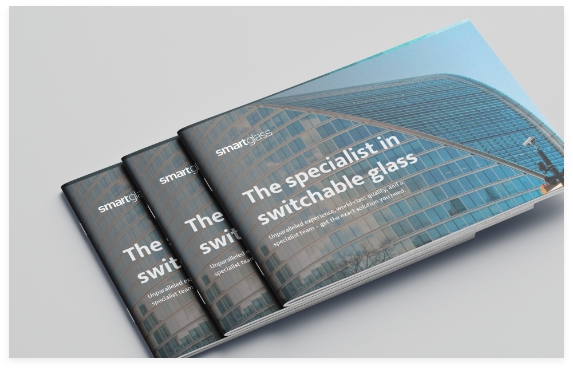Download Smartglass Brochure
spaces that adapt to users’ needs at the flick of a switch.
Technology moves at an increasingly rapid pace in the modern world, and it waits for nobody. Architects are in a particularly vulnerable position when it comes to technology. They must stay current with other key architectural aspects, such as the latest building materials and design trends, both of which also change quickly.
With so much evolving at such a fast pace, the modern architect can find it challenging to stay informed on technological advances in the field. The following article aims to introduce the innovative concept of smartglass technology and its main applications in the design of corporate buildings.
Smartglass is a unique type of switchable glass technology that allows users to alter the appearance of the glass with the flick of a switch. This electric glass operates using an electric current to adjust the appearance of the glass depending on user needs. Smartglass is a technological advancement with much promise in terms of improving building aesthetics, functionality, and privacy as the following examples show.
Building Entrance
A stylish entrance is one of the best ways to make a good impression on the visitors to or occupants of a commercial building such as a skyscraper, hotel, or office. Switchable smartglass can provide a minimalist modern aesthetic to a building’s entrance that leaves a striking first impression and helps distinguish such buildings from others in the vicinity.
Furthermore, the opportunity to customize the appearance of smartglass lends itself well to creating a bespoke design solution for building entrances. Privacy levels can be tailored for special events and other functions, or even special guests, such as high-profile celebrities staying in a hotel, for example. Switchable glass technology has the additional functional benefit of a high opacity option; this allows building managers or event organizers to temporarily (or permanently) use the glass panels as projection screens to display custom branding at the building’s entrance.
A particularly stylish example of how architects can incorporate smartglass technology when designing a building’s entrance can be viewed at East Wintergarden in London’s Canary Wharf business district, which renowned architecture firm Pelli Clarke Pelli helped build.
Hospital Design
When helping to design a hospital architects must not only consider design elements that add to the aesthetic, but also how the functionality of the building can be enhanced to cater to the patient in order to provide a more comfortable hospital stay.
New and existing hospitals are increasingly utilizing the benefits of switchable glass technology. For example, Sunderland Royal Hospital required the construction of a new partition system that allowed for monitoring of patients while simultaneously protecting privacy. Additionally, the partitions were required to meet the exacting hygiene standards of any modern hospital. The design solution for this hospital was to use switchable privacy smart glass panels, creating a smooth and seamless partitioning system along the
corridors of the ICCU and in double doors entering each ward. The smart glass panels also met the exact hygiene standards in the hospital as switchable glass panels are much easier to clean than traditional curtains or blinds, which often harbour superbugs.
A similar design solution was used in a project at St. Mary’s Paddington Hospital in London, which required the introduction of an innovative interior solution to help eliminate the threat of in-house infection and improve patient privacy. Now the hospital has incorporated switchable smartglass partitions for the ideal balance between patient privacy, stylish design, and excellent hygiene standards.
Hotel Design
Architects have a difficult job when it comes to working on projects involving hotels because hoteliers always request the latest technologies and design features that can enhance their guests’ experiences when staying at their hotels.
Smartglass can be incorporated in hotel room design; for example, by amalgamating the bedroom and bathroom into one larger space with switchable glass partitions to provide adequate privacy as needed via the flick of a switch. Some of the benefits to an open design plan for a hotel room are that it allows for more natural light to enter the room, maximizes space, and helps guests feel more comfortable as if they were at home.
Kempinski Hotels and Resorts in Bahrain hired Woods Bagot architects to elevate the standard partition wall to a high-end design feature, which this architecture firm achieved through the installation of smartglass. Smartglass technology was used to similar effect in The Brew House Hotel in Tunbridge Wells, where bespoke en suite designs provide a sleek and minimalist façade through which en suites can be revealed or concealed in an instant.
Switchable glass technology is an emerging and important technology that architects can utilize to provide more stylish and functional design solutions to commercial buildings. To learn more about Smartglass products, contact the team at Smartglass International today.

Wherever you are in the world one of our team will be in touch to advise on the best smart glass solution for your needs.